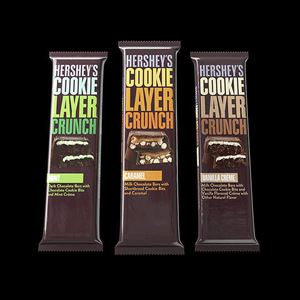
Hershey cuts calories, but can it sell the lighter bars?
5/19/2017
PHILADELPHIA — At a convenience store outside Philadelphia, bars of Hershey-branded Cookie Layer Crunch tantalized shoppers with “dark chocolate bars with chocolate-chip cookie bits and mint creme.”
So was the new 200-calorie minty treat selling? “Not so much,” cashier Mary Beattie said.

Hershey’s Cookie Layer Crunch bars are among the lighter treats that company leaders herald as the firm’s future.
But, she added, “when we put Reese’s up here, they really move.”
Herein lies the challenge for the Hershey Co.: how to squeeze more revenue from its brands with new flavors and a “lighter eat” as the Pennsylvania company navigates such trends as e-commerce and sugar-wary consumers.
Company CEO Michele Buck says she wants to “reignite” its core confection business while reformulating and resizing sugar-rich products and even looking beyond candy. One new product theme is the Cookie Layer Crunch, a chocolate bar with cookie bits plus caramel or creamy mint.
It won’t be easy for Hershey.
Packaged-foods companies, from the cereal-maker General Mills to Campbell Soup, have faced weak sales and declining market shares as consumers seek fresh produce and healthier products, leading to big-food mergers. Hershey rejected a buyout offer in 2016 from the global Oreo-maker Mondelez International, which has a market capitalization about three times larger. Mondelez responded by vowing to compete more directly against Hershey in its most critical market: the United States.
“Consumers either want more healthier options or they want to indulge themselves,” said Diana Rosero-Pena, a consumer-goods analyst for Bloomberg Intelligence. Hershey, she said, has to “cater to the consumer without losing sight that they are a mainstream chocolate company.” She predicts Hershey can do it.
Hershey’s recent annual sales growth peaked in 2012 at 9.3 percent. Then problems at Hershey’s just-acquired Shanghai Golden Monkey unit, combined with other weakness, led to an unusual 0.5 percent sales decline by 2015. Revenue rebounded slightly in 2016, with a 0.7 percent gain. Hershey now forecasts sales gains of about 2 percent this year as it launches new flavor variations: Key lime pie-filled Twizzlers, coconut-almond Kisses, strawberry Kit Kats, and others.
But there are headwinds. More people shop online — thus fewer impulse buys at the cashier — and CVS has even warned that it would pull candy from the front of hundreds of its stores, to make room for healthier choices.
While working with retailers on new candy displays, Hershey also announced last month that it would cut the calories in many of its individually wrapped products to 200 or fewer by 2022. The goal is to have half of its single-sale products at that reduced-calorie level, up from a third now.
Separately, Hershey has said that, by 2020, it would reformulate its branded products with “simple, familiar ingredients.”
Hershey spokesman Jeff Beckman said the latest Food and Drug Administration guidelines, published in December, 2015, recommend an average American daily diet of 2,000 calories, with no more than 10 percent of those calories from added sugars.
Hershey’s 200-calorie goal is “roughly based” on the latest FDA recommendation, he said.
Reduced calories will be accomplished through innovation, reformulation, and product-size reduction, Mr. Beckman said. New products also will be launched with 200 calories.
At the annual shareholders’ meeting this month, Ms. Buck cited the strengths of its core brands: Hershey, Reese’s, Kit Kat, Ice Breakers and Kisses, but said the future would be snacks with a “lighter eat.”